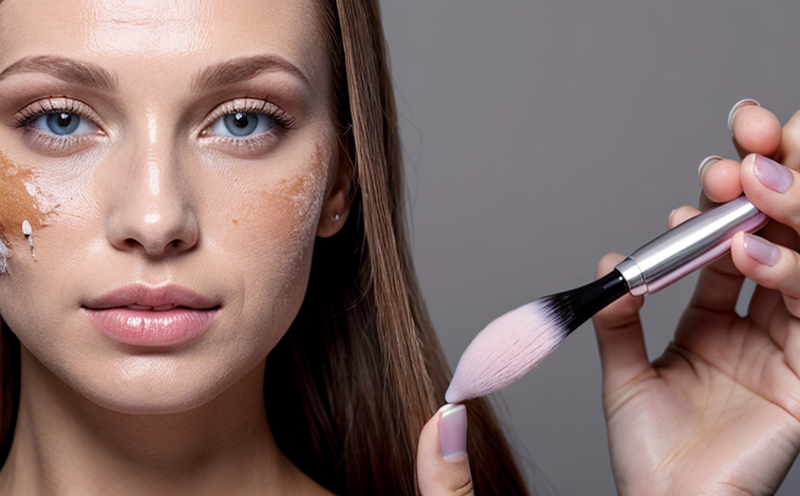Lead Limit Compliance Testing in Lipsticks
In the realm of cosmetics testing, ensuring product safety and compliance with regulatory standards is paramount. Lead limit compliance testing for lipsticks plays a critical role in safeguarding consumer health by detecting trace amounts of lead that may be present in cosmetic products. This service ensures that manufacturers meet stringent international regulations such as those outlined in the FDA's Cosmetic Ingredient Review and EU regulation (EC) No 1223/2009.
The process involves several key steps. First, lipstick samples are collected using aseptic techniques to prevent contamination. The sample preparation requires homogenization of the lipstick to ensure that all components are evenly distributed for accurate measurement. Subsequently, the prepared sample is analyzed using advanced analytical instrumentation such as Inductively Coupled Plasma Mass Spectrometry (ICP-MS).
The ICP-MS technique allows for precise quantification down to parts per billion levels, making it ideal for detecting even trace amounts of lead. After analysis, results are compared against established limits set by regulatory bodies like the FDA and EU. Compliance is determined based on these limits; for lipsticks, the acceptable level of lead is generally less than 1 ppm.
Understanding the implications of lead contamination in cosmetics is crucial given its potential health risks. Chronic exposure to even low levels of lead can cause various adverse effects including developmental issues and neurological damage. Hence, rigorous testing ensures that products are safe for consumer use. This service not only protects consumers but also enhances brand reputation by demonstrating a commitment to quality and safety.
Quality managers and compliance officers benefit significantly from this service as it provides them with critical data needed to meet regulatory requirements. R&D engineers can leverage these test results to refine product formulations, while procurement teams ensure that raw materials used in lipstick manufacturing are lead-free or within permissible limits.
Applied Standards
The service adheres strictly to several international standards designed to ensure consistent and reliable testing results. Chief among these is the FDA's Cosmetic Ingredient Review (CIR) guidelines, which mandate thorough safety evaluations of cosmetic ingredients including lead limits in lipsticks.
In Europe, compliance with EU regulation (EC) No 1223/2009 is essential. This directive not only sets the framework for cosmetics but also mandates rigorous testing procedures to ensure that all components are safe and within specified limits. Additionally, ISO standards provide further guidance on sample preparation, analytical methods, and reporting protocols.
| Standard | Description |
|---|---|
| FDA Cosmetic Ingredient Review (CIR) | Guidelines for cosmetic ingredient safety evaluation. |
| (EC) No 1223/2009 | European regulation covering cosmetics, including lead limits in lipsticks. |
| ISO Standards | Procedures for sample preparation and analytical methods. |
Environmental and Sustainability Contributions
The service contributes positively to both environmental stewardship and sustainability efforts by promoting the use of lead-free or low-lead content in cosmetics. By reducing the presence of toxic elements like lead, this practice minimizes environmental impact during manufacturing processes and disposal phases.
Moreover, adhering to stringent regulatory standards encourages innovation within the cosmetic industry towards greener technologies and practices. This shift towards safer alternatives supports broader sustainability goals by fostering a culture of responsibility among manufacturers. Consumers also play an integral role in this context; choosing products that meet these high standards promotes healthier ecosystems and reduced pollution.
Manufacturers adopting this service not only enhance their product safety but also contribute to sustainable development objectives set forth by global organizations such as the United Nations Environment Programme (UNEP).
Use Cases and Application Examples
- Quality Assurance: Routine testing to ensure lipstick batches meet regulatory requirements.
- New Product Launches: Initial safety checks before market release.
- R&D Innovation: Investigating new ingredient combinations for reduced lead content.
- Supplier Audits: Verification of raw material suppliers' compliance with lead limits.
| Use Case | Example Scenario |
|---|---|
| Routine Testing | A large cosmetics company conducts regular testing on lipstick batches produced at various factories. |
| New Product Launches | A startup launches its first lipstick line, ensuring all products are tested for lead limits before going to market. |
| R&D Innovation | An R&D team explores novel natural extracts that can replace lead-based stabilizers in lipsticks. |
| Supplier Audits | A manufacturer audits its raw material suppliers to ensure they meet the lead limit standards set by regulatory bodies. |





